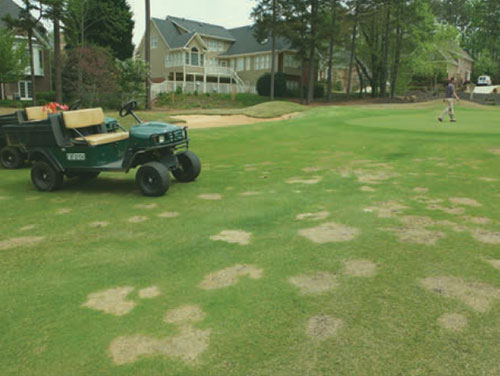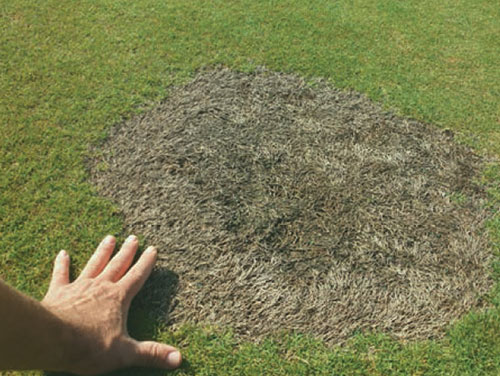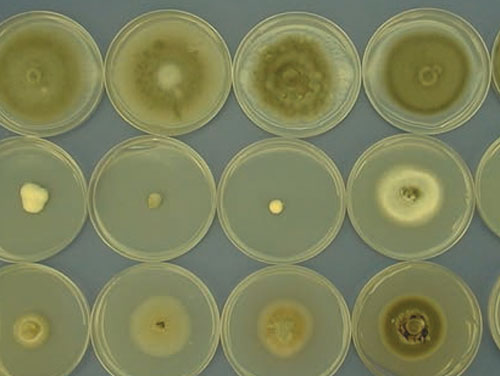Spring Dead Spot Overview
Spring Dead Spot (SDS) is an important root disease of common Couch Grass. Read on to learn more about solutions on how to control SDS.
Overview
The problem
Spring dead spot (SDS) is an important root disease of common Couch Grass [known in the US as Bermuda Grass (Cynodon dactylon) and hybrid Bermuda Grass (C. dactylon x transvaalensis)]. SDS is most damaging on Couch Grass that experiences winter dormancy, especially in areas where freezing injury occurs. Typically, SDS is most problematic in the transition zone but it also can occur in regions where prolonged cool winters create slow Couch Grass growth over extended periods. The disease has also been occasionally reported on Zoysia Grass and Buffalo Grass. SDS is caused by any one of three closely related, ectotrophic, root-infecting fungi: Ophiosphorella herpotricha, O. korrae and O. narmari. The species causing SDS may vary by region, and differences in how they cause disease are not yet fully understood. Generally, these fungi infect roots from late summer until early autumn and damage roots, stolons and crowns. The SDS damage exacerbates root death caused by cold temperature winter injury. Typically, affected areas do not emerge from dormancy or grow slowly in the spring, and are prone to invasion by weeds.
What to look for
Signs of Spring Dead Spot infection initially appear as small brown flecks on roots, stolons and rhizomes. Eventually, SDS progresses and Couch Grass roots become rotted and discoloured, with black sunken lesions. In spring, as Couch Grass breaks dormancy, above ground symptoms appear as circular or arc-shaped patches of straw-coloured leaves. Green leaves on the periphery of SDS patches appear to die back from the leaf tip downwards. On golf courses, severe SDS symptoms (circular, well-defined and sunken patches) can develop on hybrid Couch Grass fairways and are often associated with areas of high traffic/soil compaction.
Spring Dead Spot is a perennial disease and once established, symptoms can reoccur at the same location. Following disease initiation, the radius of each patch will generally increase in size each year. Over time, patches can coalesce and result in very large areas of dead Couch Grass. SDS is most common on established Couch Grass that is at least three years old but can develop on sites of all ages.
The solution
Cultural practices can reduce spring dead spot and are the first step to enable SDS control:
- Variety. Couch Grass can have good resistance to SDS; associated with low-temperature tolerance.
- Drainage. Optimise root zone with good drainage to maximise root growth potential.
- Cultivation. Practice vertical mowing and core aerification twice per season (summer only).
Dedicate® is labelled for control of spring dead spot and is effective when applied at 2 litres per hectare. Dedicate combines a DMI and a strobilurin solution for SDS that has provided control equal to current standards. Dedicate gives improved turf health without the negative growth regulation effects that can be attributed to other fungicides.
Important application strategies are necessary to target SDS with Dedicate: time the first autumn application when the average soil temperature at a 50 mm depth falls below 24°C. A second autumn application is recommended 28 days later; the average soil temperature at a 50 mm depth should be above 15°C. Water in each fungicide application to move the product into the root zone.
Technical Information
Spring Dead Spot
| Solution | RATE (per 1000 sq ft) | APPLICATION INTERVAL2 |
| Dedicate | 2L | Autumn, 2 applications, 28 days apart |
|
Three closely related fungi are responsible for spring dead spot of Couch Grass. Isolated from roots and plated on agar media, they include Ophiosphorella korrae (top row),O.narmari (centre row) and O. herpotrica (bottom row). |

Spring Dead Spot patches can be 25–300 mm and more in diameter. High traffic areas with soil compaction, such as a Couch Grass golf green approach, are most susceptible to SDS damage. |

Close-up of a severe Spring Dead Spot patch symptom in a Couch Grass fairway. This patch is approximately 450 mm in diameter. |

Numerous small Spring Dead Spot patches in a single, untreated strip have coalesced to cause extensive damage in a Couch Grass fairway maintained for research during spring, 2014. |
To find out more information about our products and services, reach out to our team.
Always read the label before use.
Back to Other Diseases
